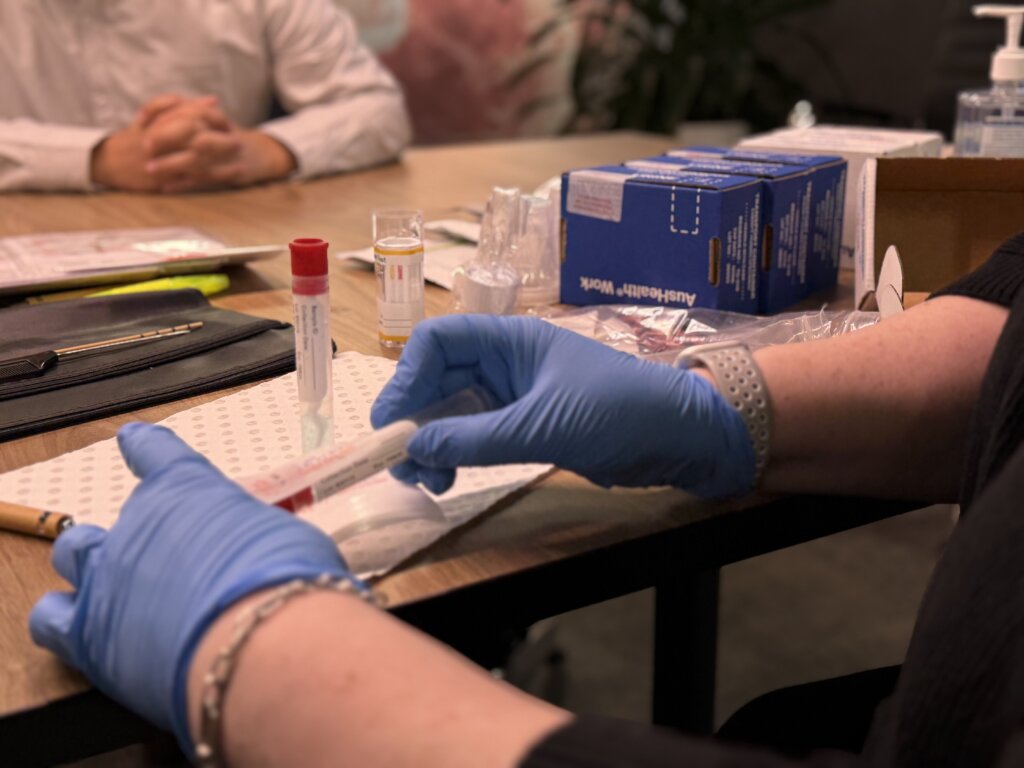How often should you conduct random drug testing in the workplace?

When it comes to maintaining a safe and compliant workplace, drug and alcohol testing isn’t about catching people out. It’s about protecting your workers and contributing to a healthier workplace.
In industries where impairment could cause harm, such as mining, healthcare, transport, manufacturing or construction, drug and alcohol testing programs act as both a deterrent and a safety control.
But how often should random drug and alcohol testing actually happen?
This is a worthy question that should formulate part of your workplace policy. Because balance is important. Too infrequent testing, and it loses its deterrent power; too much, and you risk operational fatigue or perceptions of unfairness. Current best practice, supported by AusHealth’s own research, recommends finding the middle ground: a consistent, risk-based testing schedule that upholds both safety and trust across the workplace.
Why does random drug testing matter?
Random drug and alcohol testing remains one of the most effective ways to identify and deter misuse in the workplace.
Every employee should have an equal chance of selection at each test event, ensuring fairness and transparency. A strong testing regime helps prevent impaired workers from entering high-risk environments while also reassuring your workforce that safety is everyone’s priority.
What is the right drug testing frequency?
Testing frequency is not a one-size-fits all approach and will depend on the aims of the organisation, the nature of the workforce, the anticipated rate of non-negative or confirmed positive test results, and the size of the tested population. This will sometimes be a complicated matter, and expert advice may be necessary. However, some general points can be made that can help establish how frequently testing may be performed.
Organisational factors
Organisational size and structure.
Stratified from administrative through professional and consultants to trades and manual workers. Distance from upper levels of hierarchy may tend to increase dissociation and separation of values.
Smaller organisations with up to 50 employees are encouraged to test everyone at least once a year. Businesses with up to 250 workers should aim to test around half to all employees across six to twelve sessions each year, while large organisations with more than 500 workers may plan for 30 to 50 per cent of their workforce to be tested across roughly a dozen sessions annually.
In practice, this means each employee should be tested at least once every two years, though higher-risk environments may opt for annual or quarterly programs.
Nature of engagement
Permanent, contracted or casual/itinerant/seasonal workers also differ in values and perceptions.
Industry sector
Different commercial and industrial sectors may exhibit different rates of compliance with workplace drug and alcohol policies and in the preferred form of drugs that are used.
Safety-sensitive industries such as mining, transport and utilities often conduct random testing monthly or quarterly. Moderate-risk sectors, including manufacturing and logistics, may choose biannual or quarterly testing. In lower-risk environments, such as government or office-based workplaces, annual blanket testing or periodic random sampling may be sufficient to maintain compliance and culture.
Workforce factors
Location
There are differences in the drug use experiences of businesses in metropolitan and rural areas. In particular, remote and isolated work are risk factors for drug and alcohol misuse, especially where workers may have lower levels of supervision and support.
Job satisfaction
Tasks and duties that are viewed as repetitive, menial, or unrewarding, or those where the work rate or work demands are excessive and outside the worker’s control may lead to increased absenteeism, poor work outcomes and higher rates of drug and alcohol use.
Mobile workers
Similar to remote and isolated work, largely unsupervised mobile workers (sales personnel, drivers etc) who have infrequent contact with central administrative offices may be less engaged, cease workdays early, and may be more prone to drug and alcohol misuse.
Safety sensitive
Duties and tasks that are demanding, emotionally intense, and stressful represent high risks.
Safety culture
A strong awareness and engagement with responsibilities, and workplace ethos and mission are more likely to generate and maintain a culture of compliance. This is facilitated through regular workforce communications and engagement.
Random drug testing timing
Testing should not only be randomised in who is tested but also when.
Tests conducted on Monday mornings, for instance, are more likely to detect weekend drug or alcohol use, but varying the schedule helps maintain an ongoing deterrent effect.
Combining random testing with other types of testing, such as pre-employment, post-incident or return-to-work testing, provides a well-rounded safety strategy that covers both prevention and response.
Is random drug testing worth the cost?
Yes! Drug and alcohol testing has an upfront cost, but the long-term benefits, including fewer incidents, improved productivity and reduced liability, far outweigh it.
As AusHealth’s toxicology team notes, the cost of poor workplace culture, absenteeism and accidents often exceeds the expense of testing itself.
Testing programs that align with Australian Standards, including AS/NZS 4760:2019 for oral fluid, AS/NZS 4308:2023 for urine and AS 3547:2019 for breath alcohol, are also legally defensible and protect employers from liability claims.
Best practice: the AusHealth model
AusHealth stands out as a trusted national provider because we are NATA-accredited and fully compliant with all relevant Australian Standards. Our testing devices for oral fluid, urine, hair and breath are validated for accuracy and reliability.
AusHealth offers end-to-end support, including policy design, employee education, on-site testing and toxicology interpretation.
Testing schedules are independently randomised to ensure fairness and transparency.
